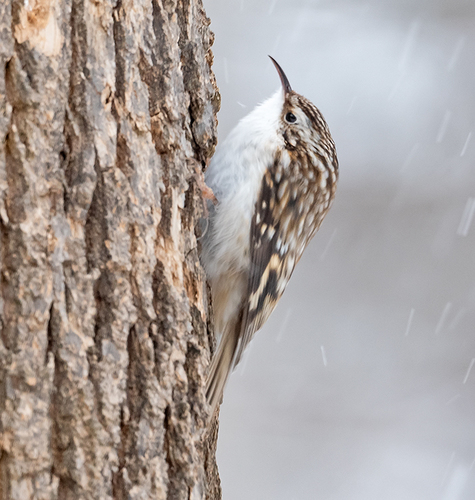
Brown Creeper
The Brown Creeper (Certhia americana) is a small, cryptic songbird found throughout North America. It is known for its unique foraging behavior of spiraling up tree trunks in search of insects, acting as an important regulator of insect populations in forest ecosystems. While not particularly flashy in appearance, its subtle beauty and specialized niche make it a fascinating subject for bird enthusiasts. It holds no major, widespread cultural significance, but its presence is often seen as an indicator of a healthy, mature forest.
11.7-13.5 cm
Length
17-20 cm
Wingspan
Least Concern
Conservation Status
Distribution
Found across North America, from southern Alaska and Canada to the southern United States and into the highlands of Central America. Migratory patterns vary; northern populations tend to migrate south for the winter, while southern populations may be year-round residents. Altitudinal range extends from sea level to high-elevation forests.
Lifespan
Average lifespan in the wild is 1-2 years, but individuals can live up to 5 years or more.
Brown Creeper's Habitat
Habitat Types
Mature forests, Mixed woodlands, Coniferous forests, Deciduous forests
Climate Zones
Temperate, Boreal, Subtropical (in highlands)
Adaptations
Strong claws and a stiff tail allow it to cling to and climb tree bark effectively. Its downward-curved bill is perfectly suited for probing crevices.
Variations
Multiple subspecies are recognized, differing slightly in plumage coloration and size, reflecting adaptations to local environments (e.g., darker plumage in humid coastal forests).
Appearance
Breeding Plumage
Plumage remains relatively consistent throughout the year.
Seasonal Feather Changes
Minimal seasonal variation.
Sex Based Plumage Differences
Males and females have very similar plumage.
Notable Features
Streaked brown and buff upperparts for camouflage, White underparts, Long, decurved bill, Stiff tail feathers used for support
Diet and Feeding
Primary Foods
Insects, Spiders, Insect eggs, Larvae
Foraging Behavior
Typically starts at the base of a tree and spirals upward, probing bark crevices with its bill. Once it reaches the top, it flies down to the base of another tree to repeat the process.
Specializations
The decurved bill is perfectly adapted for extracting insects from bark. Strong claws and a stiff tail provide stability while climbing.
Seasonal Diet Variations
May consume more seeds and small nuts during winter when insects are less abundant, but primarily insectivorous year-round.
Behavior
Social Structure
Generally solitary or found in pairs during the breeding season. May join mixed-species flocks during the non-breeding season.
Communication
High-pitched, warbling song, Short, sharp 'seet' calls, Contact calls during foraging
Migration
Northern populations are migratory, moving south for the winter. Southern populations may be resident or undertake shorter-distance movements.
Territorial or Group Behaviors
Males defend breeding territories through song and chasing. Outside of the breeding season, they are less territorial and may forage in loose flocks.
Conservation
Threats
Habitat loss and fragmentation (loss of mature forests), Pesticide use (reducing insect prey), Climate change (potential shifts in habitat and prey availability)
Protection Programs
Forest management practices that promote mature forest stands, General habitat conservation efforts
Local National Laws
Protected under the Migratory Bird Treaty Act in the United States.
Population Trend
Stable
Population Estimates
Global population estimated to be around 18 million.
Interesting Facts
They almost always climb upwards on trees.
This behavior is a defining characteristic, contrasting with nuthatches, which can climb down headfirst.
Their stiff tail feathers act like a prop.
Similar to woodpeckers, the tail provides support and balance while climbing.
They can be difficult to spot.
Their cryptic plumage provides excellent camouflage against tree bark.
Faqs about Brown Creeper
What do Brown Creepers eat?
They primarily eat insects, spiders, and insect eggs found on tree bark.
Where do Brown Creepers nest?
They build nests behind loose bark, in tree cavities, or sometimes in crevices in buildings.
Are Brown Creepers migratory?
Northern populations are migratory, while southern populations may be year-round residents.
How can I attract Brown Creepers to my yard?
Maintaining mature trees and avoiding pesticide use can help create a suitable habitat for Brown Creepers.
Copyright @ Nature Style Limited. All Rights Reserved.
 English
English